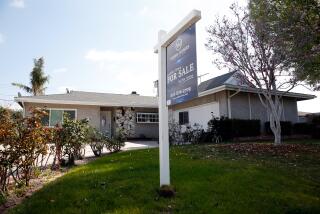Factory Orders Up 2.1% : New-Home Sales Post Surprising 9.7% Gain
- Share via
WASHINGTON — Sales of new homes rose a startling 9.7% in May for the biggest increase in eight months, the Commerce Department reported Tuesday. The Reagan Administration called the gain evidence of a “strong resumption of steady growth” in the U.S. economy.
In a separate report, Commerce said orders to U.S. factories rose 2.1% in May for the first increase since January and the biggest advance since last November.
Both government and private economists said that the latest statistics offered further evidence that the economy, aided by falling interest rates, is finally rebounding from a disappointing winter.
The 9.7% housing gain left sales of new single-family homes at a seasonally adjusted annual rate of 676,000.
At the White House, deputy press secretary Larry Speakes called the May gain a “tremendous rebound in sales” and predicted that both sales and housing construction starts would rise further in coming months.
“This is another glimpse of an economic picture that is beginning to define very clearly a strong resumption of steady growth,” he said.
Private economists gave credit for the strong sales gain, which followed an 11.5% sales drop in April, to substantial declines in mortgage rates.
Fixed-rate mortgages, which climbed above 15% last summer, have now dropped to about 12%, while adjustable-rate mortgages have declined to about 9%, housing analysts said.
Warren Lasko, executive vice president of the Mortgage Bankers Assn., said the big jump in May sales reflected the fact that more people are becoming aware of declining mortgage rates, which are at their lowest levels in five years.
“People started shopping in April, and they began buying in May,” Lasko said. “Sales in June and July should be even stronger.”
Most analysts said that they did not expect mortgage rates to fall further, but most predicted that rates will not rise either, at least through the heavy summer sales season.
Jack Carlson, chief economist for the National Assn. of Realtors, predicted that all of 1985 would see 650,000 new homes sold, a 1.8% gain from the 637,000 sold last year.
James Christian, chief economist for the U.S. League of Savings Institutions, said the decline in mortgage rates had put homeownership within reach of many more families by making the cost of a mortgage more affordable.
He said this trend was likely to halt a slide in the percentage of families owning their own homes. U.S. homeownership stood at 64.1% of the total population at the beginning of 1985, the lowest it has been since 1969. It had reached a peak of 65.6% of the population in 1980.
The price of a new home also dipped substantially in May, with analysts ascribing part of the decline to the fact that more lower-priced homes were sold during the month.
The median price of a new single-family home dropped to $81,000, 5.6% below the April median price of $85,800. The median price means that half of the homes sold for more and half for less. The average price of a home was $99,400 in May, a 5.7% decline from the $105,400 average in April and 2.5% below the May, 1984, average.
Economists were also pleased with the $4-billion gain in orders to U.S. factories, which totaled $195.1 billion in May. The 2.1% increase in new orders, the largest since a 4.4% advance in November, came primarily from a 43.5% jump in demand for military equipment.
Analysts said it was likely that the rebound in demand for manufactured goods would lead to production and employment gains in coming months, which would help lift the U.S. industrial sector out of its current slump.
The slowdown in U.S. industry has been blamed for weak growth in the overall economy in the first part of this year. The economy expanded at a barely noticeable 0.3% annual rate from January through March.
More to Read
Inside the business of entertainment
The Wide Shot brings you news, analysis and insights on everything from streaming wars to production — and what it all means for the future.
You may occasionally receive promotional content from the Los Angeles Times.










